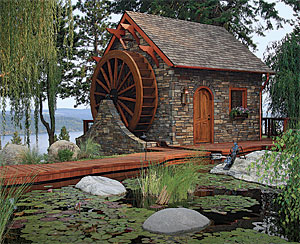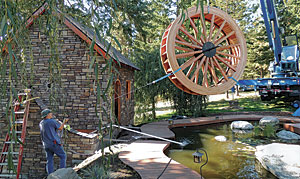During the winter of 2013, Ray Baytos convinced his wife, Joanne, that a water-wheel house would be the perfect addition to their koi pond. A hobbyist woodworker and sometime-builder for 35 years, Baytos’s waterwheel is unique in its construction. Rather than follow the traditional waterwheel design, which uses segmented sections of dimensional lumber bolted together, Baytos utilized traditional joinery techniques and modern gluing technology. He ripped about 2400 lin. ft. of redwood into strips measuring 3-1/4 in. by 3/8 in., then submerged them in a water bath. When the strips were flexible, he glued and stapled them together to form the two wheel rims. After sanding the 11-1/2-ft.-dia. rims smooth, he routed a series of pockets into each to accommodate the mortise-and-tenon joinery for the wheel’s struts. When construction of the approximately 1500-lb. wheel was complete, Baytos hired a crane service to lift it from his home workshop to the waterwheel house out back. When asked if it was worth the time, effort, and money he spent to build the house, Baytos’s answer was an unequivocal yes.
Waterwheel design and construction Ray Baytos, Coeur d’Alene, Idaho
Photographs courtesy of Ray Baytos
House design and construction Ray Baytos, with framing assistance from Bill Hannsen, Coeur d’Alene, Idaho
For more photos, see The Construction of a Water Wheel.


Fine Homebuilding Recommended Products
Fine Homebuilding receives a commission for items purchased through links on this site, including Amazon Associates and other affiliate advertising programs.

Reliable Crimp Connectors

Affordable IR Camera

8067 All-Weather Flashing Tape






















